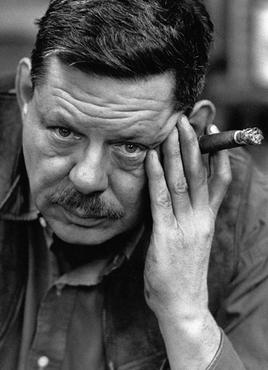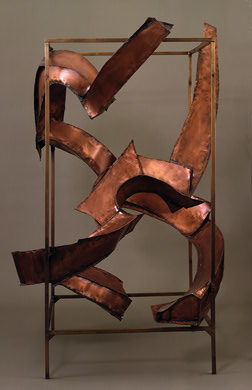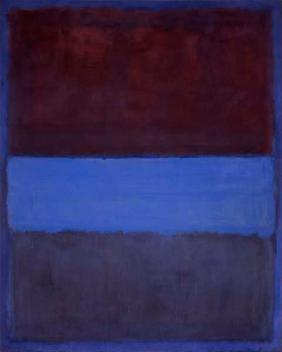Related Research Articles

Mark Rothko, born Markus Yakovlevich Rothkowitz, was a Latvian-American abstract painter. He is best known for his color field paintings that depicted irregular and painterly rectangular regions of color, which he produced from 1949 to 1970.
Abstract expressionism is a post–World War II art movement in American painting, developed in New York City in the 1940s. It was the first specifically American movement to achieve international influence and put New York at the center of the Western art world, a role formerly filled by Paris.

Barnett Newman was an American artist. He has been critically regarded as one of the major figures of abstract expressionism, and one of the foremost color field painters. His paintings explore the sense of place that viewers experience with art and incorporate simplistic forms to emphasize this feeling.

Adolph Gottlieb was an American abstract expressionist painter, sculptor and printmaker.

Roland David Smith was an American abstract expressionist sculptor and painter, best known for creating large steel abstract geometric sculptures.

Bhupen Khakhar was an Indian artist. He was a member of the Baroda Group and gained international recognition for his work as "India's first 'Pop' artist."

Herbert Ferber was an American Abstract Expressionist, sculptor and painter, and a "driving force of the New York School."
Ruby Rose Neri is an American artist based in Los Angeles, California. She was born and raised in California's Bay Area, drawing creative influence from her parents and their friends. Her father is Manuel Neri, a prolific sculptor associated with the Bay Area Figurative Movement, and her mother, Susan Neri, is a graphic designer. Neri is both a painter and a sculptor, and has worked with a wide array of materials including clay, plaster, bronze, steel, fiberglass, glaze, acrylic, oil, and spray paint.[8] Lately, Neri has focused her practice and is primarily making clay sculpture.[7] Her work is based in abstraction and figuration, drawing inspiration from Bay Area Figuration, German Expressionism, graffiti, and folk art. Neri uses horses as a common motif in her work, which serves as a personal symbol of her youth.

Linda Levi is an American artist who lives and works in Los Angeles, California.
Sohan Qadri was a yogi, poet and a painter from India who lived in Copenhagen for 30 years. During his life, Qadri interacted with a number of well-known cultural figures including Surrealist painter René Magritte, Nobel laureate Heinrich Böll, and architect Le Corbusier. His paintings result from states of deep meditation, and are influenced by the colors of India: luminous, dye-infused works on serrated paper. He had more than 70 exhibitions in the United States, Europe, Asia, and Africa.

No. 61 is a 1953 painting by the Russian-American Abstract expressionist artist Mark Rothko. The work was first exhibited at the Museum of Modern Art, New York in 1961 but is now in the collection of the Museum of Contemporary Art, Los Angeles. Similar to Rothko's other works from this period, No. 61 consists of large expanses of color delineated by uneven, hazy shades. The Rust and Blue painting was a part of the Color Field Movement as No. 61 relies on subtle tonal values that are often variations of a monochromatic hue. Rust and Blue also uses layered coloring to enrich the hues in the painting, a quality the artist Mark Rothko described as "inner light". Rothko painted in such a way that at times paint can be seen flowing upward across the surface. This illusion can be seen in No. 61 since Rothko inverted the painting toward the final stages of his work.

Alfredo de Batuc is a Mexican American artist who was born in Mexico in 1950 but has been living and working in Los Angeles, California since 1975. De Batuc has worked in a variety of mediums including drawing, painting, ceramics, silkscreen and lithograph prints, and has also been commissioned for several special projects such as murals in the Los Angeles area. His work with Self Help Graphics during its early years and during the height of the Chicano Movement connects de Batuc to a rich history of political and artistic activism. Through this work and activism, de Batuc helped to create a collective Mexican American cultural pride and identity that was integral to the goals of the Chicano Movement. In 2005, Alfredo de Batuc was stricken with a severe case of Guillain–Barré syndrome, which has kept him from active life since, and from which he is slowly recovering.

Sasson Soffer (1925–2009) was an American abstract painter and sculptor. His work has been exhibited extensively throughout the world.

Hiroshi Senju is a Japanese Nihonga painter known for his large scale waterfall paintings.
Mono-ha (もの派) is the name given to an art movement led by Japanese and Korean artists of 20th-century. The Mono-ha artists explored the encounter between natural and industrial materials, such as stone, steel plates, glass, light bulbs, cotton, sponge, paper, wood, wire, rope, leather, oil, and water, arranging them in mostly unaltered, ephemeral states. The works focus as much on the interdependency of these various elements and the surrounding space as on the materials themselves.

Visual arts in Israel refers to plastic art created first in the region of Palestine, from the later part of the 19th century until 1948 and subsequently in Israel and the occupied Palestinian territories by Israeli artists. Visual art in Israel encompasses a wide spectrum of techniques, styles and themes reflecting a dialogue with Jewish art throughout the ages and attempts to formulate a national identity.
Eric Orr (1939–1998) is an American artist who lived and worked in Venice, California from 1965 to 1998. Before moving to Los Angeles in 1965, Orr was a civil rights worker in Mississippi. A key figure of the Light and Space movement, Orr developed alongside Southern California conceptual art and created perceptual-based installations commonly associated with Light and Space art. Orr's work spanned a variety of artistic practices (including installation art, sculpture, painting, and performance art that challenged the definition of art making. Orr's work incorporated a broad range of cultural references, including space icons found in ancient religions and cultures, Egyptian symbolism, and Buddhist spiritualism.

Jon Peterson (1945–2020) was an American artist, most known for his "guerrilla sculpture" in the 1980s and his stylistically eclectic paintings in the 2000s. He was active in the emergence of Los Angeles’s downtown art scene—partly captured in the 1982 documentary, Young Turks—as both an artist and real estate developer. His work has been commissioned by or exhibited at Los Angeles Contemporary Exhibitions (LACE), the San Diego Museum of Art, Washington Project for the Arts, Madison Museum of Contemporary Art, Houston Art Festival, Foundation for Art Resources, and the International Sculpture Conference. It has been discussed in Artforum, Art in America, ARTnews, Los Angeles Times, The Washington Post and The Village Voice, and recognized by the National Endowment of the Arts. Museum director and one-time Artforum critic Richard Armstrong wrote that his outdoor, urban "Bum Shelters" "neatly grafted function and relevance onto the sadly barren tree of public sculpture"; critic Peter Plagens called them "hand-made, subtly irregular riff[s] on Minimalism" that injected social consciousness into "erstwhile formalist work." Reviewers liken his painting practice in the 2000s to the "polymath"-model of Gerhard Richter, interchanging diverse styles and genres as a means to understanding the nature of painting itself. Peterson died March 4, 2020, at the age of 74, and is survived by his wife, Tanarat, and son, Raymond.
Casper Brindle is an American painter and sculptor living and working in Los Angeles, California. Casper Brindle creates artwork that combines influences from both the light and space and finish fetish movements, as well as elements from Minimalism and Color Field painting. His work has been exhibited in the United States and internationally.

Jack Boul is an artist and teacher based in Washington, D.C., whose oil paintings, monotypes and sculpture are included in museums including the National Gallery of Art and the Phillips Collection.
References
- 1 2 Harvey, M. (2009). "Lee Waisler". Art in America . 6 (97): 199–200. Retrieved 3 November 2011.(subscription required)
- ↑ "Citizen artist: Lee Waisler / produced by Martin Perlich ; director, editor, Michael Herzmark". Archives of American Art . Retrieved 3 November 2011.
- ↑ "Artist Bio". Art in Embassies. United States State Department . Retrieved 3 November 2011.
- 1 2 3 4 5 6 7 8 9 Hollander, John; Patnaik, Gayatri; Schwarz, Arturo; Sheffield, Margaret; Tagore, Sundaram (2002). Crossing Boundaries: The Art of Lee Waisler. India: Mapin Publishing. p. 24.
- 1 2 3 4 5 Schwarz, Arturo (1988). Mostra Retrospectiva. Los Angeles: Peace Press. pp. 1–2.
- ↑ Wendon, John (1990). The Art of Lee Waisler. London: Andre Deutsch. pp. 22–23.